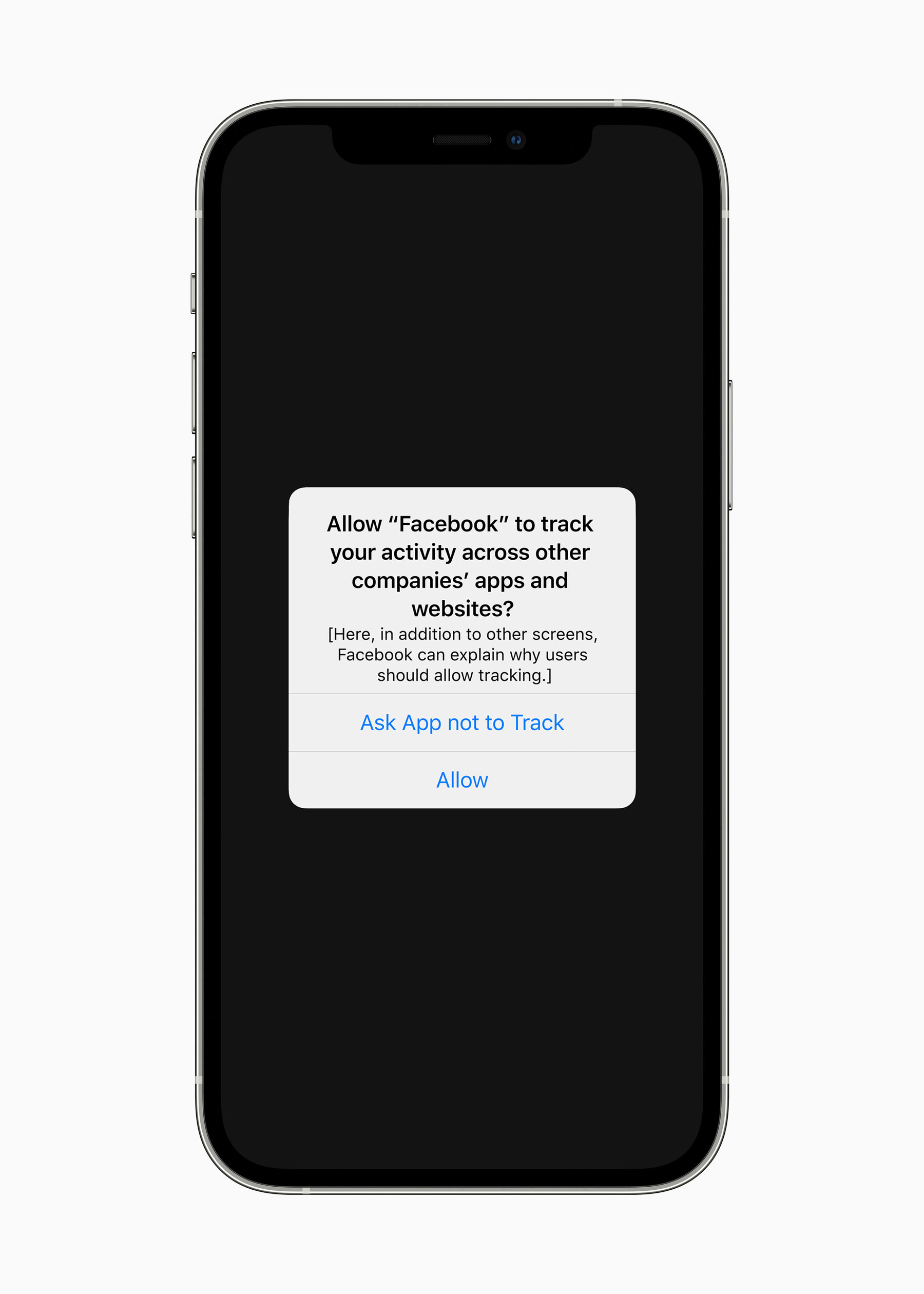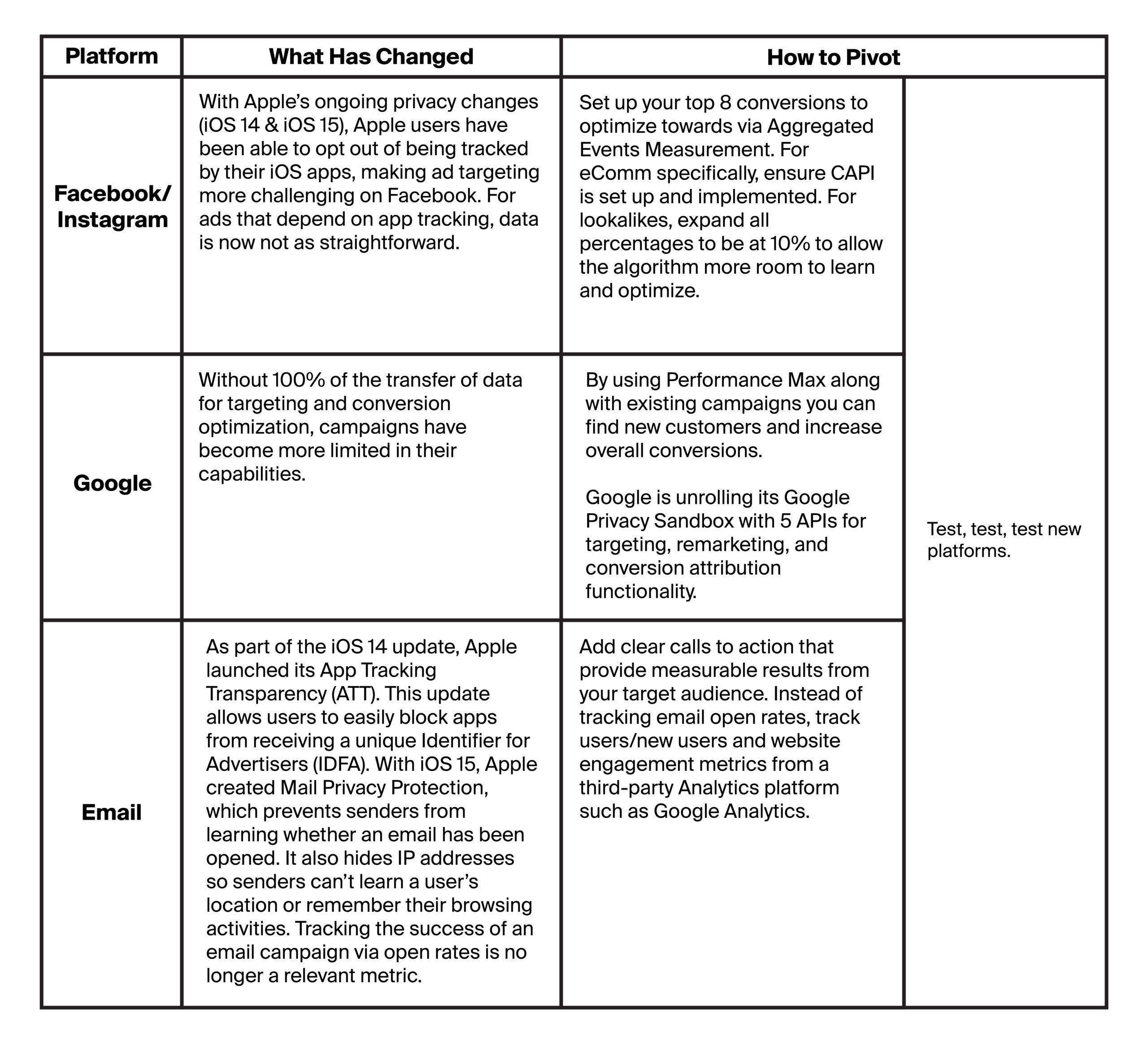The digital ecosystem is ever-changing in its nature, which means that digital ad strategies need to change and evolve, too. With all that we’ve been through in 2021, iOS14 privacy issues, platform outages, increased costs, and constant algorithm updates make digital marketing even more challenging.
In April, Apple first introduced iOS14, which included the App Tracking Transparency (ATT) feature. The ATT allows users to easily block apps from receiving a unique Identifier for Advertisers (IDFA) embedded in their iPhone devices. This fully eliminates user activity tracking across apps. As a result, the next time an iPhone user looks at or interacts with an ad, any activity tracking in place would be lost. Not to mention, the lower match rates and dip in performance for lookalike audiences and overall less information on audience performance across campaigns.
Apple owns about ~47% of the U.S. smartphone market, based on the research conducted by eMarketer. After the launch of ATT in April, only about 9% of iPhone owners initially consented to share their data. Since then, the number has increased to about 15%. But this was just the start of all the iOS 14 effects. In September 2021, iOS 15 was launched with even more privacy features. This time, email campaigns took the biggest hit. The Mail Privacy Protection inhibits senders from learning whether an email has been opened and hides IP addresses so senders can’t learn a user’s location or remember their browsing activities.

For marketers, data is king: the more information you have available to input into your campaigns, the better results you can see. With reduced data, it’s harder to reach a specified and large group of people. If you can’t access demographics and behavior data, how can you know whether somebody fits into a group or not? A quick email blast or Facebook ad that may have converted in the past has now become essentially ineffective. Digital marketers now must re-examine every strategy and tactic that has worked for years and pivot.
Let’s take a more in-depth look into channel-specific considerations and tactics that will help marketers adapt and recover from iOS 14 and on.
Paid Social
Marketing Charts reports that paid social advertising costs have increased about 25% year over year, and with increased competition and decreased targeting data, performance has been the most challenging yet. Some of this is related to advertisers re-entering the auctions post-pandemic, but it is also largely due to iOS 14 and the new limitations we face with it. With this being an issue advertisers face globally, we have some tactics to combat this.
Audience Insight
No longer having insight and breakouts to the audience and conversion demographics means it’s harder for advertisers to narrow down on their exact audiences. Before we were able to see how many more conversions males, 25-34 drove against females 35-44. Now we can only see high-level KPIs such as impressions, reach, and clicks. Luckily, CTR is still a metric we have access to (or can calculate!) — so we can make a soft inference that audiences with a higher CTR also have higher conversion rates.
Lookalikes
Before iOS 14 we could see great success with just a 1% lookalike audience; but now, our most qualified audience has become our worst-performing one. To counteract this we have seen 10% lookalikes perform better, with the 10% allowing the platform algorithms more room to expand, learn, and capture those core audience demographics.
Another option to workaround platform lookalikes is to manually create your own. By taking the demographic information on top customers across accounts and creating personas based on these people based on their available interests to include in targeting you have essentially created a lookalike of your top customer.
Pixel & Event Tracking
Overall, advertisers will see a decrease in conversions reported since iOS14 has launched. However, on platforms like Facebook implementing Conversions API (CAPI) (for e-commerce clients specifically) can help. Importing conversions to Facebook allows the algorithm to determine how to better optimize campaigns. For e-comm, if using Shopify, add Facebook to the Sales Channel, and if using WooCommerce, add the plug-in integration. CAPI has also become a nice workaround across the board to help counteract some of the new iOS updates. However, keep in mind that this will require engineering/development resources.
Facebook also now only allows eight conversions to be tracked across a single domain (also ensure your domain is verified as soon as possible!). If this isn’t set up, Facebook will auto-assign events it believes are the most relevant based on past and current pixel activity. By utilizing the Aggregated Events Measurement, advertisers can finetune the top eight conversion events to track their audiences’ journey. For purchase events, turn on advanced matching — every little bit of information you can capture counts!
Copy & Creative
Attention-grabbing images (we recommend and prefer videos/GIFs) along with copy that stands out (incorporate emojis) perform the best. Video ads are 10% of the cost of carousel or static ads. People also gaze 5X longer at video than at static posts on Facebook, which explains a lower overall cost. The key to using videos/GIFs is the audience pool you then have for retargeting those video viewers (3S VV). Remember to also keep frequencies low. The best practice is to keep it under 3 — if you see an ad that continues to perform but has high frequencies, add an emoji in the copy and change around a few words. Despite all the changes and pivoting going on from iOS14, A/B testing is still a tried-and-true method to understand what resonates best with your audience and to improve CTR, CPA, and ad performance.
Paid Search
It’s easy to assume paid social took the biggest hit when it came to the new iOS 14 updates. Sadly, SEM campaigns also suffered quite a bit. Similar to paid social, paid search platforms can only receive conversion data for those who allow tracking. Advertisers like Google have always relied on the free movement of data in order to narrow down targeting within ad campaigns; however, with the new updates, this has become more limited. Google itself is also preparing its Google Privacy Sandbox which will introduce 5 APIs as substitutes for targeting, remarketing, and conversion attribution functionality. In the meantime, before that, see below for some tactics to navigate around the new privacy updates.
Bid Strategies
Google and its reps have been recommending marketers to switch to tCPA rather than the tROAS starting late Q2 of this year. With this optimization, you should notice more consistent performance across your AdWords account. Additionally, with new accounts, marketers used to have to manually switch from eCPC to Max Conversion then to tCPA/tROAS. Now, with newer accounts marketers can automatically select tCPA and the algorithm will walk your campaigns through the steps we would’ve had to previously manually do.
Performance Max was also recently made available across all advertisers. This new strategy/tactic works in tandem with your existing SEM campaigns to help enhance performance across all of Google’s inventory and placements. Performance Max will also have additional audience segments and insights available to help with upper-funnel prospecting.
Cookies
Because most advertisers rely on third-party data, this is the reason why the iOS 14 update is so problematic. As we know, the industry has shifted away from third-party data and cookies – Google is even removing all cooking tracking from Chrome starting 2023 (the original plan was 2022, but that plan isn’t going too well for the at the moment). The longer that marketers wait to adapt to cookie-less tracking, the harder the consequences will be when all the changes are actually implemented. Gathering as much data and information as possible through websites, social media accounts, apps and all campaigns will allow for an easier transition to the cookie-less world of marketing. As all this information and data is collected, we can start to rely on this to grow lookalikes and customer lists.
Retargeting
For RLSA campaigns advertisers are definitely going to face some challenges. With FLoC (Federal Learning of Cohorts), audiences being driven from an iOS 14+ device will not be able to be individually identified; instead, they are being grouped by interests. So targeting on RLSA campaigns will be slightly inaccurate for iPhone users. Currently, there is no workaround for the impacts of iOS14 on RLSA campaigns.
Landing Pages
Marketers used to be able to send all traffic and data to one single landing page for both organic and paid, however with the new iOS14 creating dedicated landing pages along with a strong CRM platform can help advertisers follow the data all the way through from click to sale, especially if there is a long click to conversion funnel.
Going Beyond Traditional Ad Platforms
With all the new changes and roadblocks, advertisers have been hitting, diversifying advertising channels is our #1 recommendation. Facebook and Google have ruled the digital ads space for the last 10 years, but we have seen some new faces emerge that are taking the industry in a different direction. While all ad channels are impacted by the new iOS14 updates, by diversifying your advertising channels across other established platforms advertisers will not be as reliant on the big ad platforms such as Google and Facebook. Some great platforms we recommend rotating in and testing are Amazon (for eComm brands), Pinterest, TikTok, and Snapchat. We also love Affiliate and Influencer Marketing – each is a very similar approach but in separate ways, however that is very dependent on budgets and the phase of growth a brand is currently in.
Amazon
Google and Amazon are both pay-per-click platforms; however, the biggest difference between the two is that customers turn to Google for research, but most turn to Amazon when they are ready to make a purchase. In terms of a basic advertising strategy – the key component is building out manual targeting campaigns based on keyword research from automatic campaigns. As long as you have a strong advertising strategy and foundation, a strong ROAS is almost always achievable on Amazon.
Pinterest ads have proven to be extremely effective for upper and middle funnel tactics, and at times boost sales. The user demographic is majority female with the majority of users being under the age of 40. Best for eComm brands, due to the ability to save/pin ads and return back to on a later time – Pinterest users are 47% more likely to be introduced to a new brand or products than users on any other social platform.
TikTok/Snapchat
Like Facebook, Snapchat offers multiple ways to reach their customers, whereas TikTok’s currently only has the main feed as the only placement. Both platforms offer very favorable results hitting a much younger demographic, however with TikTok continuing to grow as a platform, their ad platform will be following shortly. If you don’t have the capacity to build or work with a creator on TikTok content, Snapchat has a lower barrier to entry logistically and monetarily.
Affiliate
Affiliates earn a commission for marketing another person’s or company’s products on their platforms, whether that is a blog, content platform, or website. When someone clicks an affiliate link and purchases (within the attribution window, of course), the affiliate earns a commission from sales they make. The sales are tracked by links with very specific URLs and UTM parameters. To learn more about affiliate marketing, we have an excellent guide.
Influencer
With the rise of TikTok influencer marketing has taken a turn for the better – once just a “channel” for just Instagram and YouTube, content creators can now monetize across additional platforms. The trust that an influencer builds between his/her audience is what drives such strong results from an influencer campaign if executed correctly. Read more on the Top Influencer Platforms to utilize to properly execute your campaign.
Conclusion
iOS14 has created a huge ripple effect throughout the industry, but like always it stands to serve as a way for advertisers to be resourceful and find new ways of reaching the right people, with the right message, at the right time. Not only is being reactive essential to the constantly changing environment but being proactive for future and upcoming changes is what will differentiate a strong marketer from a smart marketer. Being able to utilize the strong resources we’ve always had in our back pockets (strong first-party data and strong creatives) will allow us to stay ahead of the curve. With there being more of an incentive to push opt-in permissions across consumers and more people choosing to opt out, if you already have a strong foundation of data you can rely on targeting, and retargeting tactics become slightly easier. It can be argued that having strong ad creative is more important than refining targeting, especially with all the new targeting limitations across paid social. Getting the correct creative shown to the right audience will be a strong indicator of whether or not a campaign is marked successful. With the direction the world is moving towards and privacy with transparency being at the forefront of any activity, it’s important to remember that something that may have worked for the last 10 years may not work for the next 10. A Google Search campaign set up two years ago with multiple expanded text ads to test copy will no longer work starting June 2022 as all expanded text ads will be phased out. By testing new platforms and methodologies, new best practices will be found which just continues to prove the efficacy of paid advertising.
TL;DR






